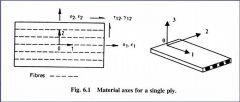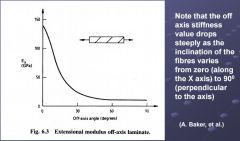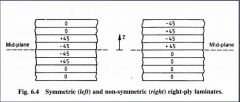![]()
![]()
![]()
Use LEFT and RIGHT arrow keys to navigate between flashcards;
Use UP and DOWN arrow keys to flip the card;
H to show hint;
A reads text to speech;
16 Cards in this Set
- Front
- Back
|
Define: - Homogeneous - Heterogeneous |
Homogeneous: same material properties at all points Heterogeneous: Has different properties at all points Page 6-2 |
|
|
Define: - Isotropic - Anisotropic |
Isotropic: Same material properties in all direction Anisotropic: Different material properties in different directions Page 6-2 |
|
|
Define: - Orthotropic - Transversely Isotropic |
Orthotropic - 3 planes of symmetry for material properties Transversely Isotropic - Material with one plane in which the properties are the same in all directions Page 6-2 |
|
|
Define directions 1,2 and 3 in terms of a composite with fibres in it. |

NOTE: Material is orthotropic along principal material directions Page 6-3 |
|
|
!!! What are the four constants for 2D lamina problems? !!! |
- Longitudinal modulus - E1, E2 - Poisson's Ratio - v12 note (v21 can be found from v12, so they are not independent) - Shear modulus G12 Page 6-4 |
|
|
What are the nine constants relevant for 3D problems? |
E1, E2, E3, G12, G23, G13, v12, v21, v13 |
|
|
Draw a graph of how the elastic modulus (E) varies as the axis angle changes from zero to 90 degrees |

Page 6-11 |
|
|
What are some assumptions made for the classical laminate theory? |
- Strain is constant through the thickness - For bending, the strain varies linearly through the thickness - The laminate is thin compared with in-plane dimensions Each layer is quasi-homogeneous and orthotropic - Displacements are small compared with the thickness Page 6-12 |
|
|
What do the 'A', 'B' and 'D' signify in the ABD matrix? |
A - is the inb plane stiffness matrix (in-plane forces and in-plane strains) D - is the bending stiffness matrix (bending moments and curvatures) B - Coupling stiffness matrix (relates to forces moments, strains and curvatures) Page 6-18 |
|
|
What affects the value of A in the ABD matrix? |
Coefficients of A are essentially the sum of the ply stiffnesses multiplied by thickness -> therefore they are independent of stacking sequence Page 6-21 |
|
|
What makes a laminate symmetric? |

If the plies are symmetric about the mid plane, B = 0 Page 6-22 |
|
|
How does B change depending on whether the laminate is symmetric or unsymmetric? |
For a symmetric laminate, coefficients of B are zero - therefore there is no coupling between in-plane forces and out of plane deformations For an unsymmetric laminate, the coefficients of B are non-zero. If an in-plane force is applied, it will bend; if a pure moment is applied to an unsymmetric laminate it will bend and stretch Page 6-21 |
|
|
What is a 'balanced' laminate? |
For every ply that is not 90 or 0 degrees, there is a ply of the negative of that angle. i.e. for every 30 degree ply, there is a -30 degree ply (+45, -45, 0, 0, +30, -30) is balanced 6-23 |
|
|
What do the coefficients A_xs represent in the ABD matrix? |
- They are the in-plane shear coupling coefficients. They relate in-plane forces to the shear strain, the in-plane shear force to the strains e_x and e_y. - They are zero for a balanced laminate - They are non-zero for an unbalanced laminate In an unbalanced laminate, axial tension will produce shear deformation, and a shear force will produce extension in addition to shear Page 6-23 |
|
|
To eliminate in-plane bending coupling and in-plane shear coupling, a laminate should be both... |
Symmetric and balanced (it is usually the aim to make laminates this way) Page 6-24 |
|
|
What is a quasi-isotropic laminate? |
All the in plane stiffnesses are independent of orientation, like an isotropic material. Bending stiffness coefficients may NOT be isotropic. Example (0, +45, -45, 90) Page 6-24 |

